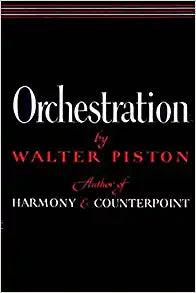
W. W. NORTON & COMPANY - 393
Orchestration
Author: Walter Piston
Publisher: W. W. Norton & Company
Pickup currently unavailable at Juilliard Store
Orchestration
Juilliard Store
Pickup currently unavailable
144 West 66th Street
New York NY 10023
United States
Choose options
Pickup currently unavailable at Juilliard Store
Orchestration
Juilliard Store
Pickup currently unavailable
144 West 66th Street
New York NY 10023
United States
Pickup currently unavailable at Juilliard Store
Orchestration
Juilliard Store
Pickup currently unavailable
144 West 66th Street
New York NY 10023
United States
In this book Walter Piston again displays those qualities that distinguished his earlier books, Harmony and Counterpoint.
Again he draws upon his own wide knowledge and experience as composer and teacher to present all phases of the subject. No practical aspect of instrumentation for the orchestra is neglected, and comprehensive treatment is given to each significant component.
The author approaches orchestration from the premise that the principles can best be presented by analysis of music as it has been written.The essentials of instrument combination discussed here are those which can be observed operating in the scores of great composers from Haydn, Mozart, and Beethoven down to our own day.
Orchestration is notable for the clarity and logic of its organization. From a consideration of the individual instruments and their technical problems the author skillfully develops his analysis of orchestration, covering his analysis of orchestration, covering instrumentation of primary and secondary melodies, part-writing, chords, and contrapuntal techniques. Finally, he discusses typical problems in orchestration together with some examples of their solutions.
Orchestration is profusely illustrated with hundreds of musical examples and with drawings of the various musical instruments that make up the modern orchestra.
The author approaches orchestration from the premise that the principles can best be presented by analysis of music as it has been written.The essentials of instrument combination discussed here are those which can be observed operating in the scores of great composers from Haydn, Mozart, and Beethoven down to our own day.
Orchestration is notable for the clarity and logic of its organization. From a consideration of the individual instruments and their technical problems the author skillfully develops his analysis of orchestration, covering his analysis of orchestration, covering instrumentation of primary and secondary melodies, part-writing, chords, and contrapuntal techniques. Finally, he discusses typical problems in orchestration together with some examples of their solutions.
Orchestration is profusely illustrated with hundreds of musical examples and with drawings of the various musical instruments that make up the modern orchestra.
